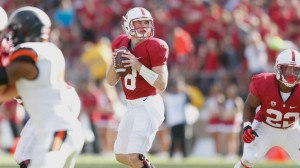‘I was blown away’: Welcome to football’s quarterback revolution
 Twenty-nine-year-old Derek Belch, a former kicker and now quality control assistant for the Cardinal, led all the meetings. Belch could've told his audience some stats like how Kevin Hogan went from completing 64 percent of his passes up to 76 percent after the Stanford quarterback started using this headset regularly for about 20 minutes before games. Or that the Cardinal went from averaging 24 points a game to 38 in those final three games. Or that the team finished the year scoring on every one of its last 27 trips to the Red Zone when their first two units were on the field, which would seem even more jaw-dropping when you consider the team was scoring just around 50 percent inside the 20-yard-line before that.
Twenty-nine-year-old Derek Belch, a former kicker and now quality control assistant for the Cardinal, led all the meetings. Belch could've told his audience some stats like how Kevin Hogan went from completing 64 percent of his passes up to 76 percent after the Stanford quarterback started using this headset regularly for about 20 minutes before games. Or that the Cardinal went from averaging 24 points a game to 38 in those final three games. Or that the team finished the year scoring on every one of its last 27 trips to the Red Zone when their first two units were on the field, which would seem even more jaw-dropping when you consider the team was scoring just around 50 percent inside the 20-yard-line before that.
Instead, Belch used subtlety to drive home just what their technological breakthrough has done for Stanford football. He revealed a detail that never shows up on a quarterback's stat line and is lost on most in the stadium but is exactly the type of thing coaches love from their QBs. Belch knew one play — a 35-yard handoff to Remound Wright in the Foster Farms Bowl against Maryland with the Cardinal up 28-7 on their first drive of the third quarter — that would resonate inside the NFL world.
The initial play call, "95 Bama," was designed as a strong-side run with one of the key blocks being the wide receiver picking up the strong safety. Problem was, Maryland's SAM linebacker was on the line and the Terps' safety was creeping up as their free safety shifted over. Hogan knew if the Cardinal ran the play as called, the receiver would have no shot to make the block, and Maryland's safety would snuff it out for a 4-yard loss. So Hogan "killed" the call and audibled to another run play where Stanford's guard was designated to kick out that safety and Wright dashed through a clear path of turf. Moments like this get to the essence of elite quarterback play every bit as much as fitting a pass between two defenders or extending a play by dodging a free blitzer. The decision had become second nature for Hogan because he'd seen it, done it, so many times in just that 20-minute session with the headset before the game.
"The first day they filmed, it looked pretty funky," Bloomgren said. "It was like eight GoPros rubber-banded together and I'm thinking, 'What in the heck are we doing?'"
The first two months of the season, Belch and his crew did a lot of experimenting. They had to gauge exactly where to put the tripod. What depth worked best? Snapping the football proved to be problematic. Where should the actual QB stand? They tried him kneeling down in front of tripod, but that didn't look right. Worse still, Belch says the stitching of the video wasn't clear, so it was blurry and it might look like Stanford had two right tackles.
The world's leading authority on virtual reality and how the brain functions in a virtual environment, Bailenson has been visited by Facebook founder Mark Zuckerberg and Google founder Larry Page, is on Samsung's advisory board and works with Navy SEALS to help figure out how Frogmen can make better decisions underwater. Bailenson and Belch, who once booted the game-winning PAT to cap Stanford's monumental upset of USC as a 42-point underdog, had spent years kicking around the idea of how virtual reality might benefit the football world. They agreed that should be Belch's thesis.
See the full story here: http://www.foxsports.com/college-football/story/stanford-cardinal-nfl-virtual-reality-qb-training-031115
Pages
- About Philip Lelyveld
- Mark and Addie Lelyveld Biographies
- Presentations and articles
- Tufts Alumni Bio